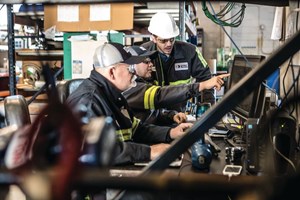United Rentals Shares Five Ways Telematics Improves Equipment Management
How well a contractor manages equipment use on a project, and its fleet in general, can make the difference between a large profit and a small one – or even none at all. United Rentals, Inc. outlined how companies can use telematics to track equipment and increase its utilization, properly maintain assets and make smarter purchasing and rental decisions.
Many contractors overspend by keeping rented equipment longer than necessary, underutilizing equipment they own or rent, and maintaining equipment before maintenance is needed or not maintaining it in time. Equipment with telematics provides remote monitoring of machines and vehicles, collecting and sending data on equipment usage, performance and maintenance needs.
With telematics, companies can learn most everything they want to know about equipment, such as location, number of operating hours, operator behavior and amount of fuel consumed. This data can be used by equipment management software to help contractors manage owned and rental fleet, including excavators, loaders, aerial work platforms and more.
“Telematics data is an essential ingredient to an effective fleet strategy that delivers positive impact to the business,” said Norty Turner, senior vice president of services & advanced solutions, United Rentals. “By providing managers with the visibility they need of the location and utilization of equipment, telematics-based fleet tracking combined with equipment management software can make jobsites more productive, cut project costs and increase the bottom line.”
Contractor Benefits from Leveraging Telematics
Here are five ways contractors can leverage telematics data to operate more safely and productively.
Track equipment location. Equipment has a way of sometimes hiding, especially on large jobsites. A skid steer may be parked in the wrong place, or someone could be “holding” a boom lift in case it is needed again. Jobsite work can stop when crews need to search for essential equipment that is missing.
Telematics systems equipped with GPS tracking can be integrated with equipment management software to locate machines on a map in real time. This visibility can stop time-consuming hunts for equipment. It can help managers right-size fleets. If a worksite has a dozer not in use, the contractor probably doesn’t need to buy or rent another one.
Reduce equipment theft and “borrowing.” When equipment is on an empty jobsite at night or on a weekend, it can be vulnerable to thieves or perhaps tempt crew members to make unauthorized use. GPS tracking and geofencing can prevent these situations.
Contractors can use fleet management software to improve security by drawing a geofence around a jobsite or specific area the machine should stay in. An alert can be set in the system to notify the contractor if the machine exits that virtual boundary. Alerts can define work hours, so companies are alerted in real time if the machine is moved, or the ignition is started, outside those hours.
Boost utilization. Rental equipment often makes up a significant project expense. By identifying utilization of each unit, equipment telematics helps contractors manage the fine line between renting too little equipment and renting too much.
Telematics devices provide a wide range of useful engine data, including engine hours. By running a utilization report in a fleet management app, a contractor can quickly see how many hours the machine was used in the past day, several days, week or month.
Knowing equipment utilization helps companies understand how much equipment is needed for jobs, guiding purchase and rental decisions. It can even increase revenue by enabling a contractor to make more accurate bids in the future.
Benchmark performance against industry peers. Scoring equipment utilization against industry benchmarks can identify areas to enhance efficiency and calculate the financial gain that can be realized. Any equipment rental supplier should be able to provide a company with data about how its equipment is utilized by market segment, job type and equipment specification.
Benchmarking provides an avenue for companies to rank every piece of rental equipment across their projects and jobsites – gauging utilization and days past due against industry norms. It can identify where equipment utilization practices fall among best-in-class, industry average and room-for-improvement performance metrics.
Gain preventative maintenance efficiencies. Operators and managers can use telematics data about equipment and vehicles to determine when maintenance tasks are needed rather than schedule maintenance based on miles or time driven. This just-in-time maintenance means a contractor is not over- or under-scheduling shop time.
Data-based maintenance can also help fleet managers better forecast maintenance budgets. The information can also be tapped by an equipment maintenance service provider supporting a company with a proactive, automated program of preventive maintenance and inspections customized to its specific needs.
Related News
From Archive

- Glenfarne Alaska LNG targets late-2026 construction start for 807-mile pipeline project
- U.S. water reuse boom to fuel $47 billion in infrastructure spending through 2035
- $2.3 billion approved to construct 236-mile Texas-to-Gulf gas pipeline
- Major water pipe break in Puerto Rico hits over 165,000 customers
- Potomac River Tunnel project enters construction phase beneath Washington, D.C.
- Pennsylvania American Water launches interactive map to identify, replace lead water service lines
- Trump's tariffs drive $33 million cost increase for Cincinnati sewer project
- Utah city launches historic $70 million tunnel project using box jacking under active rail line
- Tulsa residents warned after sewer lines damaged by boring work
- Fatal trench collapse halts sewer construction in Massachusetts; two workers hospitalized




Comments